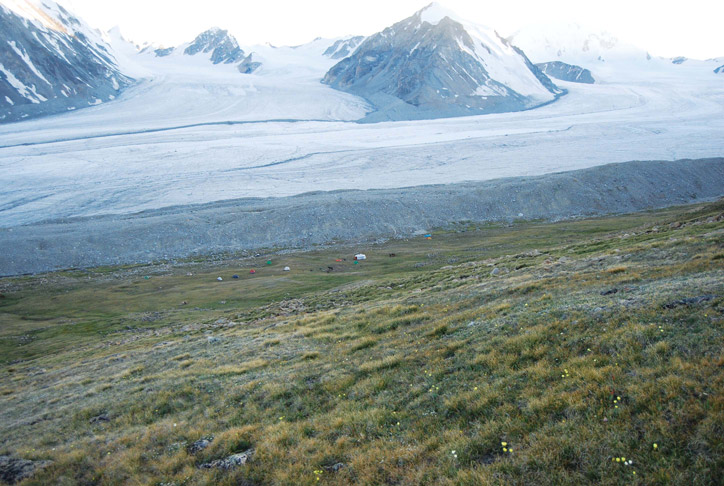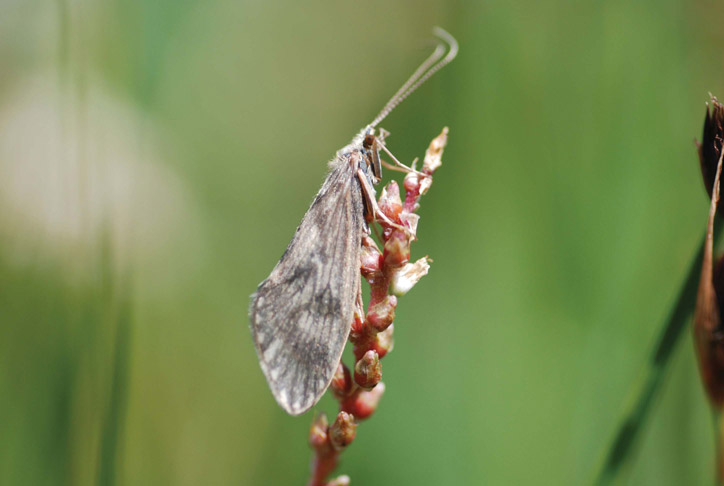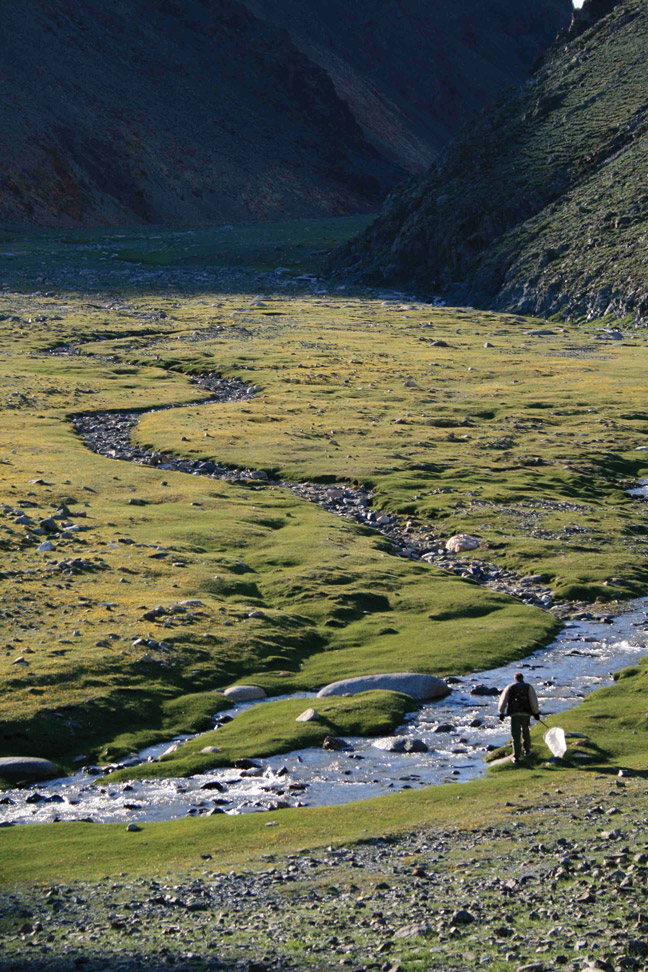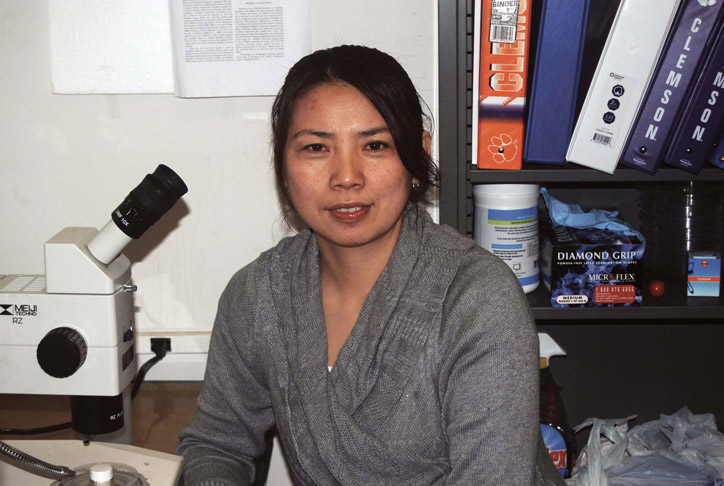Life at the edges
Taylor Reeves
Insects help lead Mongolia toward cleaner water.
 Like wildflower blossoms, tents for team members in the Mongolian Aquatic Insect Survey dot grassland at the edge of a glacier.
Like wildflower blossoms, tents for team members in the Mongolian Aquatic Insect Survey dot grassland at the edge of a glacier.It’s summer in Mongolia, and a convoy of jeeps roars into the outland regions that encompass the country’s recently thawed lakes, rivers, and streams. For three weeks, a team of scientists will cross the open landscape, boiling their own water, sleeping on the ground, and bathing in rivers. They bring along cooks who often negotiate with local farmers to buy sheep and fresh produce that will become dinner on the spot. When the team runs out of dirt road to travel by car, they hire horses and camels to traverse the rough terrain. They are armed with nets, shovels, traps, and sampling equipment as they survey and collect the rich array of aquatic insects teeming beneath the surface of the unexplored waterways.
For John Morse, an entomologist, the Mongolian Aquatic Insect Survey has constituted a significant part of his life and research for more than a decade. The survey’s goal: an inventory of aquatic macroinvertebrates—small animals that lack backbones but are visible to the naked eye. Because they reflect the health of an ecosystem, these insects can help Mongolian scientists evaluate water quality and aquatic life in their country.
What the insects reveal
The survey is a national project years in the making. It began in 2003, when scientists from around the world began cataloguing insect fauna in the Selenge River basin. The Selenge connects Hovsgul and Baikal, two of the world’s largest and most biologically diverse lakes, with numerous endemic insect species. The team examined more than 200 sites and collected more than 3,000 specimens, many of which had never been catalogued before. In 2008 the survey moved to Mongolia’s western terminal basins, which lie to the west and southwest of the Selenge River and allow no outflow to other bodies of water.
Unlike Europe and the Americas, Mongolia has not been able to draw on centuries of research to create detailed catalogues of insect fauna. That has been a liability, since scientists can use such catalogues to gauge how well different species tolerate pollution and monitor water quality by measuring the number of species in different areas. Since little is known about Mongolian insect populations, scientists are unable to monitor the country’s water quality efficiently. The Mongolian Aquatic Insect Survey will enable a more accurate water-monitoring system in Mongolia for detecting pollution from mining and herding, which threaten the country’s water supply and diminish its biodiversity.
While the team’s expeditions into the Mongolian countryside are scientific by design, they are adventurous by nature.
 The caddisfly, especially sensitive to pollution, has long been one of John Morse’s research interests.
The caddisfly, especially sensitive to pollution, has long been one of John Morse’s research interests.“When you leave town, you’d better have everything you’ll need with you because that’s all you’re going to get,” Morse says. “Every day is different, and every day is exciting.”
Mongolia’s national independence day, Naadam, often occurs during the summer expeditions, and the team celebrates according to Mongolian custom, participating in races and arm wrestling competitions and preparing a special meal of spiced meat wrapped in dough.
“During expedition, we’re like a family. We take care of each other and understand each other as we work toward a common goal,” says Oyunchuluun Yadamsuren (“Oyuna”), a Mongolian student whom Morse first met while teaching an entomology course there in 1998.
Then a sophomore at the Mongolian State University of Education, Oyuna developed an interest in aquatic entomology through Morse’s class and decided to pursue a career in the field. When Morse returned in 2001 to teach a second course, Oyuna volunteered to work as a lab assistant. Her enthusiasm prompted Morse to recommend her to Gelhaus for the initial aquatic insect survey.
Creating a new technique
Oyuna, who is working toward her Ph.D. under Morse’s direction, explores a new technique of using information collected in the Mongolia Aquatic Insect Survey to monitor the country’s water quality. The Environmental Protection Agency (EPA) recommends a metrics-based system for water assessment, which involves numerically evaluating different species’ ability to tolerate pollution and calculating average tolerance levels for different areas.
The mayfly, stonefly, and caddisfly species are generally sensitive to pollution and are thus particularly useful for this technique. A large number of taxa from these three insect orders indicates good water quality. In Mongolia, there are about 250 species of mayflies, stoneflies, and caddisflies. Globally, there are more than 3,000 species of mayflies, 3,500 species of stoneflies, and 14,400 species of caddisflies.
Oyuna proposes to diverge from the metrics-based system in favor of a traits-based system for which she would use the environments and physical characteristics of different species to determine water pollution levels. She will evaluate twenty to thirty biological and ecological traits, such as the temperature each species lives in and how it obtains oxygen, and she hopes to determine which traits are prevalent and which are scarce in polluted environments.
While Oyuna’s research could be applied in many locations, the traits-based system is particularly valuable for Mongolia. Tolerance levels used for the EPA metrics system were developed in a different environment than that of Mongolia, where rivers and lakes are situated on flat plains rather than in forests. The EPA system was designed to detect organic pollution, and Oyuna’s system would work to detect mining pollution as well. Although the metrics system works well for countries with a well-established history of taxonomic research, the traits-based system would be adaptable for the special conditions in Mongolia.
 Entomologist Sigitas Podenas of Vilnius University, Lithuania, samples from a stream meandering the Altai Mountains in Mongolia as part of the survey.
Entomologist Sigitas Podenas of Vilnius University, Lithuania, samples from a stream meandering the Altai Mountains in Mongolia as part of the survey.When she finishes her dissertation, Oyuna will return home to Mongolia. While the country’s modernization isn’t new to her, it is different from what Morse encountered when he first visited in 1996—a country emerging from seventy years of Soviet rule.
“Back then, the buildings were drab, the streets were broken and potholed, and there was limited connection with the outside world,” he says. “Now you see five-star hotels, skyscrapers, many international visitors, and of course, loads of traffic in the city center.”
Science has changed as well. When Morse first began teaching in Mongolia, there were no scientists engaging in aquatic entomological research there. Today, nineteen freshwater biologists have established their own professional society in the country.
“For me,” Morse says, “the opportunity to introduce the whole discipline in Mongolia has been thrilling. I’m meeting academic children and grandchildren every time I go back.”
In appreciation of their efforts, Morse and Gelhaus together received the distinction of “Best Scientist for Nature and the Environment” by the Mongolian government in July 2011.
John Morse is professor emeritus of entomology in the School of Agricultural, Forest, and Environmental Sciences of the College of Agriculture, Forestry, and Life Sciences. The Mongolian Aquatic Insect Survey is led by John Gelhaus of the Academy of Natural Sciences at Drexel University, whose research on aquatic entomology in Mongolia began with John Morse in 1996.
Primary funding for the research is from the National Science Foundation.
Taylor Reeves is a senior majoring in English at Clemson.




